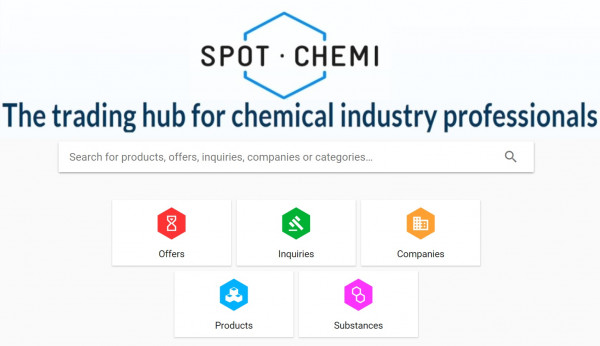-
How AI is Creating Smarter Chemical Products
Continue ReadingPeople aren’t as clever as they think they are; and that includes you and me.
This is because of the all the information we don’t know we don’t know.
Computers are also not as clever as we think they are. Only a few years ago was one able to beat a human at chess. While anyone who has ever used Google translate will know that it could easily be renamed Gobbledygook translate.
This is because, up till now, computers have only ever known what we have told them. Artificial intelligence means that they are about to get a lot, lot smarter. Smart enough to analyse complex problems with more data than the human brain can handle, and yet reason an answer through logic as a human would.
This will have a profound impact on the chemical industry; a raw material sourcing, production, and sales industry packed full of data, processes, logistics and price margins that requires high-powered analytical thinking.
While still relatively new, AI is already being applied by a number of leading companies to make better chemical products.
One such company is the Tokyo-based firm Showa Denka (SDK), which by applying cutting-edge computing in their R&D projects has found a way to increase the efficiency of its polymer design operation.
As the company press release explains, “Researchers from Showa Denka (SDK), [in cooperation with the National Institute of Advanced Industrial Science and Technology (AIST), and the Research Association of High-Throughput Design and Development for Advanced Functional Materials (ADMAT)] conducted AI-based searches for polymers with desired properties. Aiming to demonstrate the effectiveness of AI technology in the process of polymer design, they focused on glass transition temperature, an index of heat resistance. Using 417 different types of structural data on polymers with known structures and glass transition temperatures, they conducted an AI-based search for a polymer with the highest glass transition temperature to see whether it is possible to shorten the development cycle.”
The result was that, “The researchers succeeded in discovering a target polymer with the highest glass transition temperature with an extremely small number of trials, namely, [an average of] 4.6 trials. This figure is about one-fortieth of the number of trials required under random selection of polymers, confirming the effectiveness of AI-based polymer design.”
The results surprised everyone, as the computer was able to predict an optimal polymer design for a specific task with fewer trials, in less time, and with less data than was previously thought possible.
Another project that has successfully applied AI for material development is based at Osaka University. This research focused on using AI computing for the automated selection of materials for organic photovoltaic (OPV) solar cells. These cells are made up of an organic component and a semiconducting polymer.
As the online industry journal Chemical Engineering explains, “The work sought to maximize the power-conversion efficiency (PCE) of OPV cells by determining the optimal combination of organic and polymer materials, a process that typically requires a great deal of time-consuming trial-and-error experimentation. Using AI and machine learning, the team was able to evaluate data from 1,200 different OPV cells to target the optimal set of properties — in this case, band gap, molecular weight and chemical structure — to quickly determine which ones would be most efficient, and then screen polymers for their predicted PCE.”
Once the AI had made its choices, the team was able to evaluate which of the resulting materials were most practical for manufacturing.
This particular form of AI application is called ‘random forest’ machine learning, as it requires the computer to form a network of decision trees for data classification and regression.
As the study’s co-author, author Akinori Saeki says, “Machine learning could hugely accelerate solar cell development, since it instantaneously predicts results that would take months in the lab. It’s not a straightforward replacement for the human factor – but it could provide crucial support when molecular designers have to choose which pathways to explore.”
Beyond the lab, AI is also helping chemical producers to optimise their current product ranges. By using AI to help consumers get the most out of their chemical products, Henkel has found a way to utilize high-powered computing and computer reasoning to aid chemical sales. To this end, Henkel employed AI for boosting hair product sales for its Schwarzkopf Professional range.
Dr Nils Daecke, Head of Digital Marketing at Henkel Beauty Care, explained how the system works, “With SalonLab, we are redefining the way both hairdressers and their clients are experiencing beauty in the hair salon. At the same time, we are laying the foundation for disruptive, data-driven business models, which build upon consumer insights and hair properties.”
As the Henkel website explains, “Around 10,000 hair samples were scanned, colored with different Schwarzkopf Professional products in different shades, and scanned again. Thanks to machine learning and the vast amount of scanned input, the computer is able to predict how the customer’s hair will look when a certain product is used. With augmented reality, the SalonLab Consultant App then brings the ‘output’ to life, showing the customer what he or she will look like after using a certain coloration.”
Smaller chemical companies may point out that an operation the size of Henkel can afford the resources to develop smart computing. Additionally, even if ‘off-the-shelf’ AI computing was affordable, then the time and manpower needed to collect sufficient data would still be prohibitive. It takes a lot of time to collect and process 10,000 hair samples.
This is a challenge highlighted by Tim Gudszend, global head of Adhesive Technologies and Investment at Henkel, when he noted that, “One of the biggest issues is generating all of the relevant data for a process and its influencing environment, and making this information available for a ‘big data’ solution.”
Certainly, at the beginning of any AI project, data collection may be a considerable undertaking. However, Dr Ata Zad, a polymer scientist and founder of the Canadian plastics company AxiPolymer, believes that while the amount of data needed to collect maybe daunting, it is the data’s size that makes using AI essential.
“When a company expands, the amount of new data it has to deal with grows exponentially — data relating to new clients, new formulations and products, new suppliers, new employees, and more — and it’s almost impossible to interpret these huge loads of data and get actionable intelligence from it with a traditional IT system.”
Adding that, “The only way to do this is with AI, which uses algorithms to find hidden patterns in data. These algorithms are iterative and will learn continually and seek optimized outcomes; they also iterate in milliseconds, which lets manufacturers find optimized outcomes in minutes instead of months.”
The true power of AI is its ability to handle so many data points. The chemical industry has a huge quantity of data which at present remains an untapped resource.
As Zad points out, “The main input for AI algorithms is historical data. In the polymer industry, the amount and variety of unprocessed data is incredibly high. It is clearly a matter of time until these tools become more commonly used to realize the full benefits of these data.”
If you would like to learn more about AI and its impact on the chemical industry, then you might enjoy reading ‘How Artificial Intelligence is Making Smarter Chemical Processes‘. Or take a look at other articles on the SPOTCHEMI blog page.
Photo credit: Japanesechemicalsdaily, Fticommunications, Henkel, Osaka University,& SDK
-
Chemical Procurement? It Pays to Be a Pessimist
 Continue Reading
Continue ReadingIf you are a chemical producer or supplier, it pays to be a pessimist. Disaster, either natural or man-made is usually never far away. Be it a chemical plant explosion, or market collapse, global economic sanctions, trade war, or Brexit, no one can be certain what will hit the fan, or when.
Sometimes, the impact to chemical supply chains can be catastrophic. For example, when Hurricane Harvey hit Texas last year, the full force of the storm was felt by the chemical facilities around the petrochemical hub at Houston. As Bloomberg reported at the time, “A third of U.S. chemical production has been disrupted by Harvey, boosting prices and threatening shortages for basic industrial building blocks such as chlorine.”
The estimated total cost of the damage was $125 billion, while a report by Accenture, calculated that there was a, “… chemical production output shortage of approximately 70 million pounds (31 million kilos) of ethylene per day.”
Chemical supply shortages and supply chain disruption on this scale can impact any chemical company, causing headaches for even the most prepared chemical industry professional.
So, what can chemical procurement teams and commodity pool officers (CPO’s) do to minimize the impact of situations where chemical feedstocks are severely restricted or even grind to a halt?
Technology, it seems, may have the answer.
Blockchain, specifically, has the ability to handle the millions of pieces of data across entire supply chains, to keep purchasing departments informed when things go wrong, and to help them find alternative raw material sources.
As Bhudeep Hathi, an associate director for Accenture’s Advanced Technology Center explains, “Leveraging blockchain-based solutions is an innovative way to manage both information and process deficiencies. To mitigate disruptions in an operational supply chain, for instance, a chemical company could devise a permissioned blockchain that allows critical information and data related to plant operations and supply chains to be recorded in almost real time. This would make the information available to all required stakeholders within the ecosystem of a chemical company.”
He continues in his report for Accenture by noting example of data that could be applied or linked to a blockchain. These, “… include the volume of raw, intermediate and finished products, as well as production plans. Additional data might include financial details such as invoices, purchase orders, credit details, logistics data, work permit information and employee records. This blockchain-based data would act as a ‘golden reference source’ for reconciliation and recovery in a post-disaster scenario.”
For many chemical industry professionals, however, the use of blockchain may seem to be purely theoretical or ‘pie-in-the sky’. However, as Lorenzo Zullo, stated in a recent LinkedIn conversation, “Even if it is difficult to understand how blockchain works in practice, the potential of using it to track chemicals is evident. Similar to what happened with the creation of internet; people realised its importance only once practical applications (websites, email etc.) were developed.”
Zullo is the Co-Founder of Chemycal, an enterprise that monitors global chemical legislation to predict supply chain interruptions and market closures. He is also a major advocator of the power of blockchain in the chemical industry, recently outlining his beliefs in an article on SPOTCHEMI’s networking hub for chemical industry professionals.
By joining the SPOTCHEMI network you will be able to become a part of an international platform designed to streamline the buying and selling of industrial chemicals and raw materials.
As a member you will gain these valuable business advantages:
- A free service for presenting your chemical products
- A ‘find and locate’ service for the chemical products you need
- View the latest chemical price changes and trends
- Make new business contacts with like-minded chemical industry professionals
- Receive online inquiries to buy your chemical products from genuine purchasers
- Expand your chemical business by meeting trusted chemical suppliers
- Track your trading team’s deals and communication chains in one place
- Inspect potential clients visiting your company profile
Here he described how, “Blockchain is a technology potentially highly suited to addressing supply chain challenges by creating a single, global, secure and trusted infrastructure to exchange and track chemical-related information along supply chains and across sectors. Managing efficiency, security, reliability, targeted accessibility and transparency among economic operators at different levels of the supply chain.”
But, as yet, the rethinking of chemical supply chains, the transparency between chemical consumers and suppliers, the use of digital purchasing or trading with blockchain, and the ‘expect-the-worst’ mentality hasn’t permeated through the chemical industry.
For example, a 2016 survey of commodity pool officers by Deliotte found that, “62% of CPOs increasingly feel their teams lack the skills needed to deliver their procurement strategy,” and “60% of CPOs do not have a clear digital strategy.”
Without a clear strategy, or the skills to implement it, it is difficult to imagine much success at chemical procurement, and yet it seems that even planning in the modern world is getting harder and harder.
As AI expert, author, and celebrated futurist Gihan Perera explains during his visionary presentations, “When you create your strategic plans for the future, do you include two kinds of futures? In the past, we could see what was ahead, and could plan for that in our strategy. That’s still important, but the world is changing so fast that there’s another kind of future: the future we can’t see. How do you plan for that future as well?”
If you goal is industrial chemical procurement, perhaps the best answer is to start thinking like a pessimist.
Photo credit: Exsif, Camco, MotherJones, Accenture, ChemstationAsia, & Statescoop
-
Top 7 Ways that Chemical Industry Networking is Better Online
 Continue Reading
Continue ReadingAny half-decent businessperson will tell you of the power of networking.
Meeting new contacts, discussing the industry, and finding solutions to work challenges; All of this and more can be done at a networking event or conference.
But in the same way that shopping, dating, and even friendships have gone online, so too has networking. But is that a good thing?
In many ways, yes, online networking has advantages over face-to-face meeting with chemical industry contacts. And here’s how;
1. Convenience.
The modern chemical industry is very international, so the ability to network without leaving your office or even your home makes life much simpler. Today, chemical business networking can be done anywhere with an Internet connection; on the train to work, waiting for a bus, in the minutes between meetings … anywhere.
2. No travel.
No connecting flights, no traffic jams, no soul-less hotel rooms. Online chemical industry networking is cheaper, saves time, and is better for the environment.
3. Recorded Conversation.
Unlike at a conference, online networking can maintain a transcript of what was discussed. This can be referred to even years later, as your online networking account maintains a full record of your contacts.
4. Easy to connect.
No more business cards. No more schmoozing. Online networking shows you who in the network you have most in common with. Need to bring one of your team in on the discussion? No problem, online networking allows for multi-connectivity. Alternatively, networking accounts can be set up as a team, so selected staff can participate. No duplicate emails, no cross-talking, your entire team can stay ‘in the loop’.
5. Ongoing.
Online discussions and networking continue for as long as someone has something to say, so there’s no need to squeeze all you want to say and hear into a two-day event.
6. Speed.
Without the formalities and etiquette of face-to-face meetings, online networking allows participants to get to the point more directly. ‘Here is a topic I want to discuss. Let’s talk.’
During the last century, contacts made were more personal, and maybe lasted for decades, as people stayed in their industry or even with the same firm for their whole working lives. Today, this is less common, with people changing jobs and industries multiple times in their careers, the need for a personal, friendly connection with someone is much less important.
7. Chemical industry focused.
Online networking is able to stay on topic as well as any conference. For example, the SPOTCHEMI platform (who host this page) has been designed for chemical industry professionals to meet, interact, present themselves and their companies, discuss industry trends, and even make offers to buy and sell chemical products, all in one chemical industry hub.
Providing instant access to over 300,000 chemical industry companies, SPOTCHEMI, is a clear example of how online networking is best.
Photo credits: Taxjustice, Fime, Jabil, JellyFishHealth, & Chemconsultants







